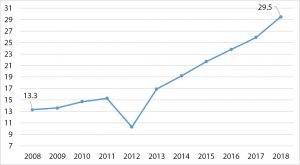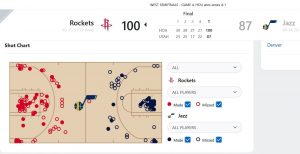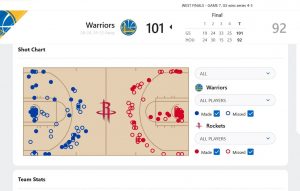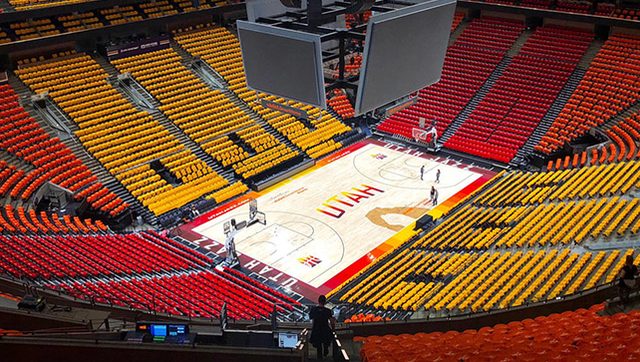Blog Post
Insight: My NBA Lament
By: James Wood
I still love the game but I’ve lost a little love. As a NBA fan for 60 years and a Jazz season ticket holder for 39 years I’ve watched my share of games; over 1,600 Jazz home games. I’ve seen the game evolved with rule changes and players skills. Today’s game is not nearly as physical. No Karl Malone with his back to the basket or John Stockton fighting hand-checking from mid-court. The game is much faster now with a premium on guards rather than centers or power forwards. On offense it’s perimeter shooters and on defense it’s the length (wingspan) of the guards. Both Donovan Mitchell and Dante Exum have wingspans of 6 foot 10, three or four inches longer than the typical guard. Milwaukee Bucks have built their current team around maximizing wingspan while the Houston Rockets have built their team around launching three point shots, no matter how much time is left on the shot clock or how many rebounders are in position.
Underlying every NBA team’s offensive and defensive philosophies are analytics (statistical analysis). The Rockets have been the pioneers in analytics but nearly all teams, coaches, broadcasters, and ardent fans have embraced some of the metrics. And along with the metrics has come a new vocabulary. No longer do we hear “with a gentle push, and a mild arc, the old cowhide globe hits home.” A few weeks ago I asked Steve Starks, president of the Utah Jazz, about the team’s use of analytics. “It’s very sophisticated. We have a group of analysts who statistically break down other teams and their players. More information is always better.[4]” Of course the nub of all the analytics is to find a way to outscore the other team. Hence the boom in three point shots. If a team takes 100 two point shots and makes 45 percent of those shots—what you would expect from an average NBA team—the team scores 90 points. If the team takes 100 three point shots and makes 30 percent they score 90 points. So if team can shoot above 30 percent for threes their chances of outscoring the other team increases. And if a team is hot from the three point line the scoring advantage just grows with the more threes they take, which usually pulls the opposing team into a three point frenzy. In the 2017-2018 season the Houston Rockets shot 3,470 three point shots. That’s exactly half of all shots taken by the team. They made 36 percent of their threes, which helped them outscore their opponents 80 percent of the time. The Jazz took 2,425 three point shots and made 37 percent. The analytics shout, “Jazz, take more threes.” And that’s just what the Jazz have been doing (Table 1). The number of three point shots taken by the Jazz has more than doubled in ten years. In 2018 the team took an average of 29.5 three per game compared to only 13.3 in 2008. The number of three point shots taken by the Jazz has more than doubled in ten years. In 2018 the team took an average of 29.5 three per game compared to only 13.3 in 2008. Table 1 Average Number of Three Point Shots Taken Per Game by Utah Jazz, 2008-2018 Source: Basketball Reference website And like a moth to a flame every team is following the analytics; more threes. But I agree, at least in part, with San Antonio Spurs coach Gregg Popovich, “I still hate it (three point shot). I’ll never embrace it. I don’t think it’s basketball. I think it’s kind of like a circus sort of thing. Why don’t we have a 5-point? A 7-point shot? You know, where does it stop? To me it’s not basketball, but you got to use it. If you don’t use it, you’re in big trouble. But you sort of feel like it’s cheating”[5] Too many threes are hurting the game.[6] The mid-range jump shot is nearly extinct in most games. Look at the shot chart for the fourth game of the conference semi-finals between the Rockets and the Jazz (Chart 1). The Jazz took four mid-range jump shots, and 29 three point shots out of 83 total attempts. Even worse was the seventh game of the conference championship between the Rockets and Golden State when the Rockets missed 27 straight threes. A seventh game of a championship series turned into a three point farce. Look at the shot chart, two mid-range jump shots by Houston (Chart 2). There’s a place for the three point shot in the game. It’s an exciting shot and gives a team a chance to quickly close the point gap. But when teams combine for 70 or even 80 threes in a game it’s a circus. Some fellow fans suggest moving the three point line beyond 23 feet 9 inches. But that might just make for more bad shots. How about putting a 20 shot cap on the number of threes per team. Any three made beyond the 20th counts as two points. It would bring another layer of strategy to the game, preserve the excitement of the three point shot and just maybe introduce a little more parity in the league.[7] Chart 1 Rockets versus Jazz, May 6, 2018 Source: ESPN NBA website, http://www.espn.com/nba/ Chart 2 Rockets versus Golden State, May 28, 2018 Source: ESPN NBA website, http://www.espn.com/nba/ James Wood is the Ivory-Boyer Senior Fellow at the Kem C. Gardner Policy Institute. _____________________________________________________________________________________________________ [1] Trademark phrase of Hot Rod Hundley, Utah Jazz announcer from 1974 to 2009. [2] NBAstuffer website, https://www.nbastuffer.com/analytics-101/ [3] Over Michael Jordan’s fifteen year career he took only 1,778 three point shots; seven percent of all his shots. Nine percent of Magic Johnson’s shots were threes, and 16 percent of John Stockton’s. In 2018 half of all James Harden’s shots were threes and 58 percent of Steph Curry’s. The evolution of the three point shot was slow and continuous from 1978, when it was introduced, to 2008. But in the last ten years we’ve seen what Stephen J. Gould, the evolutionary biologist, call “punctuated equilibrium, an episode of sudden and rapid change” and there’s no going back. [4] May 9, 2018, Newsmaker Breakfast at the Kem C. Gardner Policy Institute. [5] Interviews with CBS Sports, 2015 and USA Today 2014. [6] I know my dirge is a bit of “whistling in the wind” since viewership of NBA games is the highest in four years and according to Forbes, every team in 2018 is worth at least $1 billion. The Houston Rockets sold last year for $2.2 billion. All the owners and most of the fans love the circus. [7] Over the past 40 years only thirteen of the thirty NBA teams have won the championship; Los Angeles Lakers (10 times), Chicago Bulls (6), San Antonio Spurs (5), Boston Celtics (4), Miami Heat (3), Detroit Pistons (3), Houston Rockets (2), Golden State Warriors (2), Washington Wizards (1), Seattle Supersonics now Oklahoma City Thunder (1), Dallas Mavericks (1), Philadelphia 76ers (1), and Cleveland Cavaliers (1). And there will no newcomer in 2018 or the foreseeable future as Golden State and Houston are likely to dominate the Western Conference and Boston and Philadelphia dominate the Eastern Conference in 2019 and beyond. NBA Title Odds from Westgate Las Vegas SuperBook for 2019 title were released June 3, 2018; Golden State 5/4, Houston 7/2, Philadelphia 7/2, Boston 8/1. The Utah Jazz are 60/1, tenth best odds for a title out of 30 teams.



